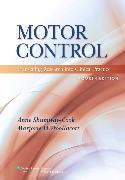|
|
|
| |
 |
|
|

|
 推薦指數:
推薦指數:





|
|
- 內容介紹
|
Motor ControlTranslating Research into Clinical Practice Author(s): Anne Shumway-Cook PT, PhD, FAPTA Marjorie H Woollacott PhD
Publication Date: Jan 21, 2011
Availability: IN STOCK
Format: Book
Edition: Fourth
ISBN/ISSN: 9781608310180
■Pages: 656
■Volumes: 656
Motor Control is the only text to bridge the gap between current motor control research and its applications to clinical practice. The text prepares therapists to examine and treat patients with problems related to balance, mobility, and upper extremity function, based on the best available evidence supporting clinical practice. This edition provides the latest research findings and their clinical applications in postural control, mobility, and upper extremity function. Drawings, charts, tables, and photographs are also included to clarify postural control and functional mobility, and laboratory activities and case studies are provided to reinforce key concepts.
Videos on the back-of-book DVD examine motor control deficits, including deficits in postural control, mobility, and upper extremity function in different types of neurologic pathology (stroke, cerebellar pathology, cerebral palsy, and Parkinson's disease) as well as in balance impaired elders. These videos can be viewed in their entirety or in the following segments: impairments, postural control, mobility, and upper extremity control. This video enhances the clinical coverage found in the textbook.
■--NEW! New case studies have been added; these case studies correspond to videos of patients on the back-of-book DVD to enhance the clinical coverage. Icons next to these case studies refer readers to the videos.
■--NEW! Additional lab activities related to the videos have been added.
■--Latest research findings and their clinical applications in postural control, mobility, and upper extremity function provide the most up-to-date information on new advances in the field.
■--Learning objectives and answer keys included in each chapter enhance learning.
■--Assessment and treatments are classified into impairment levels, strategy levels, and functional levels for easy reference. The authors have also added information on assessment and treatment related to improving participation, which is the new ICF language.
■--Drawings, charts, tables, and photographs help students visualize and better understand postural control and functional mobility.
■--Laboratory activities and case studies reinforce and apply key concepts to patients with different diagnoses.
|
|
|

